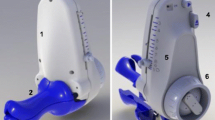Abstract
Pelvic floor protection is an issue of increasing relevance. This article sought to summarize the session at last year’s annual meeting of the German Society of Gynecology and Obstetrics (DGGG) in Stuttgart (10/2016) called “Urogynecology 2020—what is the optimal rate of cesarean section—does urogynecology have to deal with Obstetrics?”. The main focus was set on the two important anatomical structures, the levator ani muscle and the anal sphincters. Operative vaginal delivery, epidural anesthesia, and episiotomy are subject to discussion.
Similar content being viewed by others
References
Nygaard I et al (2008) Prevalence of symptomatic pelvic floor disorders in US women. JAMA 300(11):1311–1316
DeLancey JO et al (2003) The appearance of levator ani muscle abnormalities in magnetic resonance images after vaginal delivery. Obstet Gynecol 101(1):46–53
DeLancey JO et al (2007) Comparison of levator ani muscle defects and function in women with and without pelvic organ prolapse. Obstet Gynecol 109(2 Pt 1):295–302
Lammers K et al (2012) Diagnosing pubovisceral avulsions: a systematic review of the clinical relevance of a prevalent anatomical defect. Int Urogynecol J 23(12):1653–1664
Morgan DM et al (2011) Vaginal support as determined by levator ani defect status 6 weeks after primary surgery for pelvic organ prolapse. Int J Gynaecol Obstet 114(2):141–144
Tunn R (2002) Morphologie des Stressharninkontinenz-Kontrollsystems und seine pathomorphologischen Veränderungen bei Stressharninkontinenz. Habilitationsschrift, in Medizinische Fakultät Charité. Humboldt-Universität zu Berlin, Berlin
Borello-France D et al (2006) Fecal and urinary incontinence in primiparous women. Obstet Gynecol 108(4):863–872
Oberwalder M, Connor J, Wexner SD (2003) Meta-analysis to determine the incidence of obstetric anal sphincter damage. Br J Surg 90(11):1333–1337
Mous M, Muller SA, de Leeuw JW (2008) Long-term effects of anal sphincter rupture during vaginal delivery: faecal incontinence and sexual complaints. BJOG 115(2):234–238
Lenzen-Schulte M (2015) Zangen und andere Hilfsmittel: Eine Geburt ist nichts für grobe Handwerker. Frankfurter Allgemeine Zeitung (04.04.2015).
Kearney R et al (2006) Obstetric factors associated with levator ani muscle injury after vaginal birth. Obstet Gynecol 107(1):144–149
Macarthur C et al (2005) Faecal incontinence and mode of first and subsequent delivery: a six-year longitudinal study. BJOG 112(8):1075–1082
Memon HU et al (2015) Comparison of levator ani muscle avulsion injury after forceps-assisted and vacuum-assisted vaginal childbirth. Obstet Gynecol 125(5):1080–1087
Michalec I et al (2015) Vacuum-assisted vaginal delivery does not significantly contribute to the higher incidence of levator ani avulsion. Oftalmologicke Spolecnosti 80(1):37–41
Anim-Somuah M, Smyth RM, Jones L (2011) Epidural versus non-epidural or no analgesia in labour. Cochrane Database Syst Rev (12):CD000331
Agrawal D et al (2014) The effect of epidural analgesia on labour, mode of delivery and neonatal outcome in nullipara of India, 2011–2014. J Clin Diagn Res 8(10):OC03–O6
Low LK et al (2014) Predicting birth-related levator ani tear severity in primiparous women: evaluating maternal recovery from labor and delivery (EMRLD study). Open J Obstet Gynecol 4(6):266–278
Jango H et al (2014) Modifiable risk factors of obstetric anal sphincter injury in primiparous women: a population-based cohort study. Am J Obstet Gynecol 59(1):e1–e6
DeLancey JO (2008) Episiotomy: what’s the angle? Int J Gynaecol Obstet 103(1):3–4
Bader W, Aigmueller T (2014) Leitlinie zum Management von Dammrissen III. und IV. Grades nach vaginaler Geburt. AWMF 015/079, pp 1–36
Carroli G, Mignini L (2009) Episiotomy for vaginal birth. Cochrane Database Syst Rev 1:CD000081
Fodstad K, Staff AC, Laine K (2014) Effect of different episiotomy techniques on perineal pain and sexual activity 3 months after delivery. Int Urogynecol J 25(12):1629–1637
Sultan AH, Editorial (1999) obstetrical perineal injury and anal incontinence. Clin Risk 5:193–196
Baghestan E et al (2012) Risk of recurrence and subsequent delivery after obstetric anal sphincter injuries. BJOG 119(1):62–69
Ozyurt S et al (2015) Screening occult anal sphincter injuries in primigravid women after vaginal delivery with transperineal use of vaginal probe: a prospective, randomized controlled trial. Arch Gynecol Obstet 292(4):853–859
Wilson D et al (2014) UR-CHOICE: can we provide mothers-to-be with information about the risk of future pelvic floor dysfunction? Int Urogynecol J 25(11):1449–1452
Author contributions
MH: project development, litsearch, and manuscript writing/editing. SYB: manuscript writing/editing. RT: manuscript writing/editing. GN: manuscript writing/editing. CR: manuscript writing/editing. HA: project development and manuscript writing/editing.
Author information
Authors and Affiliations
Corresponding author
Ethics declarations
Funding
There is no funding.
Conflict of interest
There are no conflicts of interest.
Ethical approval
This article does not contain any studies with human participants or animals performed by any of the authors.
Rights and permissions
About this article
Cite this article
Huebner, M., Brucker, S.Y., Tunn, R. et al. Intrapartal pelvic floor protection: a pragmatic and interdisciplinary approach between obstetrics and urogynecology. Arch Gynecol Obstet 295, 795–798 (2017). https://doi.org/10.1007/s00404-017-4316-x
Received:
Accepted:
Published:
Issue Date:
DOI: https://doi.org/10.1007/s00404-017-4316-x




